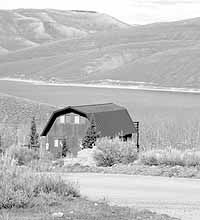| A Scofield cabin overlooks the reservoir located in Carbon County. Although many local residents enjoy a getaway to a cabin in the woods, many more enjoy a camping trip to a Utah public land. Before heading for the hills, campers are advised to become familiar with current facility regulations and rules. |
As the weather continues to heat up, Carbon County residents will start heading for the hills to participate in camping events.
This year is no different from the past several. The drought conditions are expected to persist therefore, the fire danger will be high.
Outdoorsmen are encouraged to participate in safe camping habits and ensure that the Utah wilderness is there to enjoy for future generations.
The Utah Bureau of Land Management reminds Utahns about proper camping techniques for both undeveloped and designated camping sites.
Undeveloped campsites are found throughout the public lands and are administered by the land management agency. Such campsites are located more than 100 feet from streams, at roadside turnouts and near interesting rock formations.
These types of campsites are generally recognized by the presence of a fire ring.
The BLM explains that most campers prefer dispersed campsites because they feel they have the freedom to set up camp as they please with a large number of friends.
Pets are also allowed in these areas and most do not require payment to use.
Campsites such as these have few regulations, but visitors must be aware of these guidelines before using a public facility.
Camping at one of these sites is generally limited to 14 days per visit and it is extremely important that what is packed in is later packed out.
The land management agency stresses to camp 100 feet away from springs so that water is accessible to wildlife.
At any camping location, it is important to remember to never leave a campfire unattended.
The BLM explains that Utah public lands are being discovered by an increasing number of visitors. As a consequence, many campsites are showing signs of deteriorations.
The agency recommends that in order to increase the ability of dispersed sites to accommodate successive groups of campers, it is important for all visitors to adopt a minimum-impact style of camping.
To do so, the BLM recommends that campers stay at previously used camp sites if possible.
Research studies have shown that the most rapid negative changes to soil and vegetation occur during the first few times a campsite is used indicated the land management agency.
If it is necessary to camp at a previously unused location, the BLM provides the following minimum impact camping techniques that can reduce such impacts.
•Maintain the beauty of campsites by staying on existing travel routes.
•Avoid driving, riding or walking over areas where the vegetation is intact.
•Do not put cans, bottles or aluminum foil into a fire ring. These items do not burn and their presence will lead subsequent users of the site to build a new fire ring.
•Avoid building new fire rings.
•Redundant fire rings scar the natural beauty of sites and reduce the amount of space available for sleeping and cooking areas.
If the site that is selected already has trash in the fire ring, please clean it out and place the trash in a bag for proper disposal.
•Use only dead and down wood for campfires.
•Both dead and live trees add to the scenic qualities of campsites. Leave them for the next visitors to enjoy and as habitat for desert animals.
•Burn campfire logs to ashes then douse with water.
•Do not smother a campfire with soil, this will make it difficult for the next visitor to use the same fire ring.
•Dispose of human waste properly. The disposal site should be located well away from streams, campsites and other use areas. Toilet paper should be placed in a small plastic bag and put into a trash bag.
•Pack out the trash that is brought in and take a little extra out.
For years, public land managers have promoted the pack-it-out concept in an effort to foster a self-cleanup ethic among public land users.
This program has generally been successful. Most people no longer leave or bury trash at campsites.
While the pack-it-out program has reduced the amount of trash left by campers and day users on the public lands, it has not entirely eliminated unsightly trash.
Campers can take an additional step by picking up trash left by less thoughtful people.
This act helps maintain the scenic beauty of public lands and frees land managers for other work explained the BLM.
Throughout the state, there are also developed campgrounds. These are areas that are designated for camping use and most of the time require a service fee.
Most of the above listed rules apply to these campgrounds as well. The following also apply for developed campground areas.
•Visitors appreciate the quiet of the mountains. Keep noise to a minimum. The BLM advises that quiet hours are between 10 p.m. and 6 a.m. at these sites.
•Vehicles are only allowed on specified roadways and should be parked in designated areas only.
The BLM indicated that off highway vehicle use is not allowed in developed campground areas.
•Although some areas allow animals, pets must be on a leash at all times.
•Discharge of firearms or use of fireworks are prohibited in public Utah campgrounds.
•Campgrounds may be adjacent to private lands. Respect private property and keep all gates closed.
•The land management agency advises campers to report vandalism or unsafe conditions to the nearest BLM office.
Recreationalists are urged to respect these rules and regulations, but foremost, the land management agency advises that this year campers stay safe and have fun.

